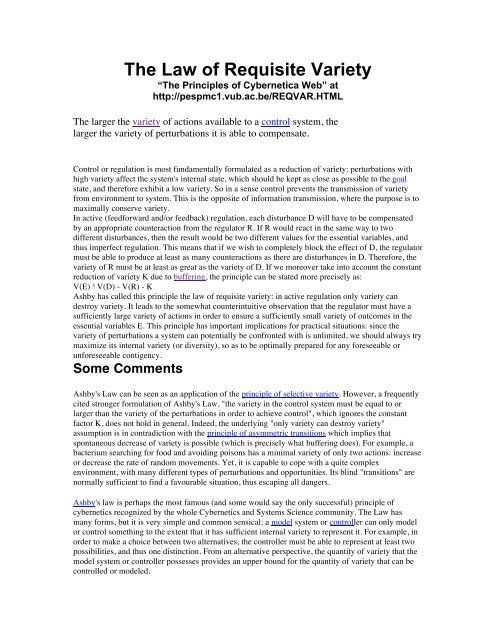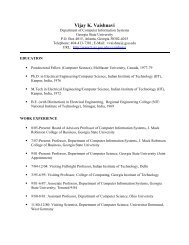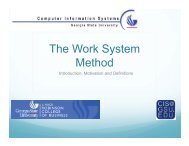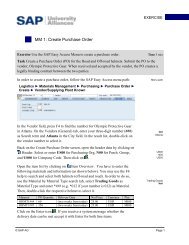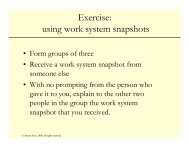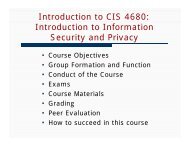Cybernetica-The Law of Requisite Variety
Cybernetica-The Law of Requisite Variety
Cybernetica-The Law of Requisite Variety
Create successful ePaper yourself
Turn your PDF publications into a flip-book with our unique Google optimized e-Paper software.
<strong>The</strong> <strong>Law</strong> <strong>of</strong> <strong>Requisite</strong> <strong>Variety</strong><br />
“<strong>The</strong> Principles <strong>of</strong> <strong>Cybernetica</strong> Web” at<br />
http://pespmc1.vub.ac.be/REQVAR.HTML<br />
<strong>The</strong> larger the variety <strong>of</strong> actions available to a control system, the<br />
larger the variety <strong>of</strong> perturbations it is able to compensate.<br />
Control or regulation is most fundamentally formulated as a reduction <strong>of</strong> variety: perturbations with<br />
high variety affect the system's internal state, which should be kept as close as possible to the goal<br />
state, and therefore exhibit a low variety. So in a sense control prevents the transmission <strong>of</strong> variety<br />
from environment to system. This is the opposite <strong>of</strong> information transmission, where the purpose is to<br />
maximally conserve variety.<br />
In active (feedforward and/or feedback) regulation, each disturbance D will have to be compensated<br />
by an appropriate counteraction from the regulator R. If R would react in the same way to two<br />
different disturbances, then the result would be two different values for the essential variables, and<br />
thus imperfect regulation. This means that if we wish to completely block the effect <strong>of</strong> D, the regulator<br />
must be able to produce at least as many counteractions as there are disturbances in D. <strong>The</strong>refore, the<br />
variety <strong>of</strong> R must be at least as great as the variety <strong>of</strong> D. If we moreover take into account the constant<br />
reduction <strong>of</strong> variety K due to buffering, the principle can be stated more precisely as:<br />
V(E) ³ V(D) - V(R) - K<br />
Ashby has called this principle the law <strong>of</strong> requisite variety: in active regulation only variety can<br />
destroy variety. It leads to the somewhat counterintuitive observation that the regulator must have a<br />
sufficiently large variety <strong>of</strong> actions in order to ensure a sufficiently small variety <strong>of</strong> outcomes in the<br />
essential variables E. This principle has important implications for practical situations: since the<br />
variety <strong>of</strong> perturbations a system can potentially be confronted with is unlimited, we should always try<br />
maximize its internal variety (or diversity), so as to be optimally prepared for any foreseeable or<br />
unforeseeable contigency.<br />
Some Comments<br />
Ashby's <strong>Law</strong> can be seen as an application <strong>of</strong> the principle <strong>of</strong> selective variety. However, a frequently<br />
cited stronger formulation <strong>of</strong> Ashby's <strong>Law</strong>, "the variety in the control system must be equal to or<br />
larger than the variety <strong>of</strong> the perturbations in order to achieve control", which ignores the constant<br />
factor K, does not hold in general. Indeed, the underlying "only variety can destroy variety"<br />
assumption is in contradiction with the principle <strong>of</strong> asymmetric transitions which implies that<br />
spontaneous decrease <strong>of</strong> variety is possible (which is precisely what buffering does). For example, a<br />
bacterium searching for food and avoiding poisons has a minimal variety <strong>of</strong> only two actions: increase<br />
or decrease the rate <strong>of</strong> random movements. Yet, it is capable to cope with a quite complex<br />
environment, with many different types <strong>of</strong> perturbations and opportunities. Its blind "transitions" are<br />
normally sufficient to find a favourable situation, thus escaping all dangers.<br />
Ashby's law is perhaps the most famous (and some would say the only successful) principle <strong>of</strong><br />
cybernetics recognized by the whole Cybernetics and Systems Science community. <strong>The</strong> <strong>Law</strong> has<br />
many forms, but it is very simple and common sensical: a model system or controller can only model<br />
or control something to the extent that it has sufficient internal variety to represent it. For example, in<br />
order to make a choice between two alternatives, the controller must be able to represent at least two<br />
possibilities, and thus one distinction. From an alternative perspective, the quantity <strong>of</strong> variety that the<br />
model system or controller possesses provides an upper bound for the quantity <strong>of</strong> variety that can be<br />
controlled or modeled.
<strong>Requisite</strong> <strong>Variety</strong> has had a number <strong>of</strong> uses over the years , and there are a number <strong>of</strong> alternative<br />
formulations. <strong>Variety</strong> can be quantified according to different distributions, for example probabilistic<br />
entropies and possibilistic nonspecificities. Under a stochastic formulation, there is a particularly<br />
interesting isomorphism between the LRV, the 2nd <strong>Law</strong> <strong>of</strong> <strong>The</strong>rmodynamics, and Shannon's 10th<br />
<strong>The</strong>orem .<br />
See also: Dictionary: LAW OF REQUISITE VARIETY<br />
Reference: Heylighen F. (1992): "Principles<br />
<strong>of</strong> Systems and Cybernetics: an evolutionary perspective", in: Cybernetics and Systems '92, R. Trappl<br />
(ed.), (World Science, Singapore), p. 3-10.
<strong>Variety</strong><br />
<strong>Variety</strong> is a measure <strong>of</strong> the number <strong>of</strong> distinct states a system can be in<br />
<strong>The</strong> set <strong>of</strong> all possible states that a system can be in defines its state space. An essential component <strong>of</strong><br />
cybernetic modelling is a quantitative measure for the size <strong>of</strong> that state space, or the number <strong>of</strong> distinct<br />
states. This measure is called variety. <strong>Variety</strong> represents the freedom the system has in choosing a<br />
particular state, and thus the uncertainty we have about which state the system occupies. <strong>Variety</strong> V is<br />
defined as the number <strong>of</strong> elements in the state space S, or, more commonly, as the logarithm to the<br />
basis two <strong>of</strong> that number:<br />
V = log 2 (|S|)<br />
<strong>The</strong> unit <strong>of</strong> variety in the logarithmic form is the bit. A variety <strong>of</strong> one bit, V=1, means that the system<br />
has two possible states, that is, one difference or distinction. In the simplest case <strong>of</strong> n binary variables,<br />
V = log 2 (2 n ) = n is therefore equal to the minimal number <strong>of</strong> independent dimensions.<br />
Background<br />
<strong>Variety</strong> has always been a fundamental idea in Cybernetics and Systems Science, and is so in<br />
Metasystem Transition <strong>The</strong>ory. <strong>Variety</strong> is defined as a multiplicity <strong>of</strong> distinctions. <strong>The</strong> existence <strong>of</strong><br />
variety is necessary for all change, choice, and information. A reduction in the quantity <strong>of</strong> variety is<br />
the process <strong>of</strong> selection. If variety has thus been reduced, i.e. if actual variety is less than potential<br />
variety, then we say that there is constraint.<br />
Frequently the quantity <strong>of</strong> variety and the change in the quantity <strong>of</strong> variety (positive increase or<br />
negative decrease) is critical to understand system evolution. Where variety is manifest in a process,<br />
then we sometimes want to say that there is uncertainty about the outcome <strong>of</strong> the process; when that<br />
uncertainty is relieved but the occurrence <strong>of</strong> one <strong>of</strong> the possibilities, then we gain information. <strong>The</strong><br />
are many possible ways to measure the quantity <strong>of</strong> variety, uncertainty, or information. As defined<br />
above, the simplest is the count <strong>of</strong> the number <strong>of</strong> distinct states. More useful can be the logarithm <strong>of</strong><br />
that number as a quantity <strong>of</strong> information, which is called the Hartley entropy. When sets and subsets<br />
<strong>of</strong> distinctions are considered, possibilistic nonspecificities result . <strong>The</strong> most celebrated are the<br />
stochastic entropies <strong>of</strong> classical information theory, which result from applying probabilistic<br />
distributions to the various distinctions.


